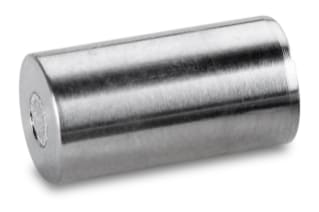
|
Chemistry |
C4 |
|
Separation Mode |
Reversed Phase |
|
Particle Substrate |
Hybrid |
|
pH Range Min |
1 pH |
|
pH Range Max |
10 pH |
|
Maximum Pressure |
6000 psi (415 Bar) |
|
Endcapped |
No |
|
Silanol Activity |
Low |
|
Molecular Weight Range Max |
150000 |
|
Particle Shape |
Spherical |
|
Particle Size |
3.5 µm |
|
Pore Size |
300 Å |
|
QC Tested |
Protein |
|
Format |
Sentry Guard Cartridge |
|
Surface Area |
185 |
|
System |
HPLC |
|
Particle Technology |
BEH |
|
USP Classification |
L26 |
|
Inner Diameter |
2.1 mm |
|
Length |
10 mm |
|
Carbon Load |
8 % |
|
UNSPSC |
41115709 |
|
Application |
Protein |
|
Brand |
XBridge |
|
Product Type |
Guards |
|
Units per Package |
2 pk |

XBridge Protein BEH C4 Sentry Guard Cartridge, 300 Å, 3.5 µm, 2.1 mm x 10 mm, 2/pk
The QC-tested and improved XBridge Protein BEH C4 Columns are designed to separate proteins according to their size, hydrophobicity, and isoelectric point. In comparison to traditional C18 phases, the C4 ligand is less retentive, resulting in less protein carryover, increased protein recovery, and improved peak capacity. The Sentry Guard cartridge is designed to extend the analytical column's column life.
Protein analysis and characterization necessitate the detection of minute chemical differences between large molecules. Such analyses have typically relied on a variety of analytical techniques, each of which is sensitive to a different property of the protein. Protein separation frequently produces relatively broad, asymmetrical peaks with poor recovery and significant carryover. To address these unsatisfactory results, we specifically designed our reversed-phase, Ethylene-bridged Hybrid (BEH Technology) Protein Separation Technology Columns for high-resolution protein analysis.
To ensure good peak shape, efficiency, and stability, the packing materials for the XBridge Protein BEH C4 Columns and XBridge Protein BEH C4 Sentry Guard Cartridge are developed in a cGMP, ISO 9002 recognized facility using an ultra-pure reagent. Each batch of lab equipment material is subjected to peptide separation, with the results restricted to specific ranges. This is done to ensure consistent, high-quality peptide separation. To learn more about additional Waters product offerings similar to and compatible with the XBridge Protein BEH C4 Sentry Guard Cartridge listed here, please browse our website or brochure to shop for lab equipment to replenish your stock and add to your existing equipment portfolio.
We also recommend that you look into the Cytochrome C Digestion Standard, which was made by digesting Bovine Heart Cytochrome C (Uniprot # P62894) with sequencing grade trypsin. As evidenced by the certificate of analysis that comes with each batch of digestion standard, each batch is made under strict quality control guidelines. Protein digestion standards can be used to evaluate and benchmark HPLC and UPLC columns, as well as to assess the performance of mass spectrometry and chromatography instruments.
How Can I Carry Out Filtration In Chromatographic Experiments In A Laboratory?
Before introducing the sample, introduce roughly 1 mL of air into the syringe. This step enables the air to escape alongside the sample, facilitating an "air purge" that minimizes fluid retention within the filter device. Subsequently, fill the syringe with the filtered solution. With one hand holding the filter device, gently connect the filled syringe to the filter device by twisting it (without exerting excessive force). To initiate the filtration process, apply gentle pressure.